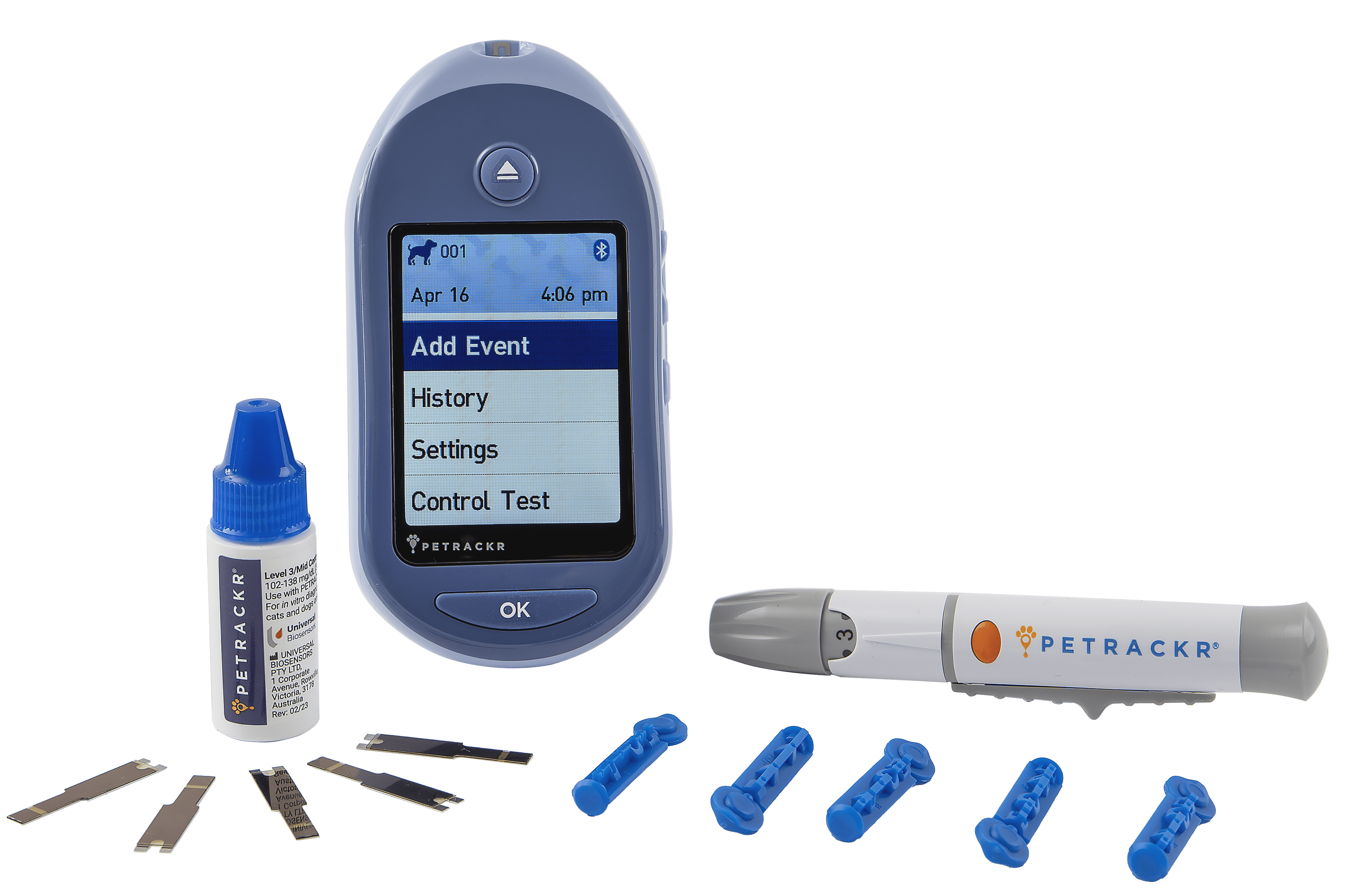Written & Reviewed by an approved Veterinary Medical Writer

A glucometer is a handheld medical device designed to measure the concentration of glucose (sugar) in blood, used by individuals with diabetes to monitor their blood sugar levels regularly.
As diabetes is a condition that affects both humans and pets, there are both human and pet glucometers that are available. Keep reading to learn more about these glucometers and their many differences.
How do human and pet glucometers work?
Here is a generalised explanation of how glucometers work:
Blood sample collection
Whether for humans or pets, obtaining a blood sample is a pivotal step in glucose monitoring. Users employ a lancet to gently prick the fingertip or an alternative site for pets, ensuring a small and manageable blood droplet for the subsequent testing process.
Application to test strip
The collected blood droplet is carefully applied to a disposable test strip, a vital component of the glucometer. This strip contains specialised enzymes that play a crucial role in the chemical reaction necessary for glucose measurement.
Signal generation
As a result of the chemical reaction, an electrical current or other measurable signals are generated. The intensity of these signals corresponds directly to the blood glucose plasma equivalent ratio of the sample, forming the basis for the accurate measurement of blood glucose levels.
Conversion to numerical value
Once the signals are captured, the glucometer performs a rapid and precise conversion, turning the measured signals into a numerical value. This numerical representation is a direct reflection of the concentration of glucose in the blood, providing a quantitative measure for the user.
What are the differences between human and pet glucometers?
Human and pet glucometers, while sharing the same purpose of measuring blood glucose levels, have critical differences that take into account the physical, genetic, and even species differences of the test subject, including:
Blood sample collection
When it comes to blood sample collection, pet glucometers acknowledge the anatomical differences and preferences of animals. They are designed to accommodate alternative testing sites, such as the ear or paw pad, recognising the need for flexibility in sampling locations for different animal species.
On the other hand, human glucometers are typically designed for the common practice of fingertip blood sampling in human glucose monitoring. This design reflects the familiarity and convenience associated with this method for human users.
Test strip composition
The composition of test strips plays a critical role in the accuracy of glucose measurements. Specialised test strips for pet glucometers take into account the variations in blood composition between species, as there are significant differences. This ensures that the test strips provide accurate measurements for animals, aligning with the unique physiological aspects of pets.
In contrast, test strips for human glucometers are meticulously formulated and optimised for the characteristics of human blood. Humans have a higher ratio of glucose to plasma glucose than dogs and other domestic animals.
Communication and handling
Human glucometers are designed for direct use by individuals, often incorporating advanced features like data storage, trend analysis, and connectivity to external devices. These features cater to the needs of human users who may benefit from comprehensive data management and analysis.
In contrast, pet glucometers focus on simplicity and efficiency for pet owners. They are designed with straightforward functionality to ensure ease of handling during glucose testing, considering the diversity of pet owner experiences and knowledge levels.
Species-specific calibration
To ensure accuracy in glucose readings, glucometers undergo species-specific calibration. Pet glucometers are calibrated to accommodate the different blood composition of animals. This species-specific calibration ensures accurate and reliable glucose measurements for a variety of pets.
On the other hand, Human glucometers are calibrated to the characteristics of human blood, providing precise readings for human users.
Specifically, there is a notable difference between the distribution of glucose in the blood of humans and the blood of cats and dogs:
- In dogs, 87.5% of the glucose is located in plasma and 12.5% of the glucose in the red blood cells.
- In cats, 93% of the glucose is located in plasma and only 7% of the glucose in the red blood cells.
- In humans, 58% of the glucose is located in plasma and 42% of the glucose in the red blood cells.
Additionally, there are differences in packed cell volume (PCV) among humans, dogs, and cats. For instance, dogs typically have a PCV of 37-55%, cats 24-45%, and humans typically have a PCV range of 37-50%. This indicates significant variation in the number of red blood cells across species.
User guidance and experience
The user experience is a crucial aspect of glucometer functionality. Pet glucometers are designed to offer clear guidance for pet owners. The design and user interface take into consideration the diverse range of pet owner experiences and knowledge levels, ensuring accessibility and ease of use for all. Additionally, the app collates relevant information on your pet’s blood to show to your vet, informing their medical decisions based on accurate values.
Human glucometers, in contrast, often have user interfaces and guidance tailored for human interaction. This includes providing information and feedback in a way that resonates with human users, enhancing their overall experience.
Can you use a human glucometer on pets?
Using a human glucometer on a pet is not recommended due to several reasons related to the physiological and anatomical differences between humans and animals. Here are some key factors explaining why a human glucometer is not suitable for pets:
- Using a human glucometer on a pet introduces the risk of inaccurate blood glucose readings, which can lead to incorrect assessments of the pet’s health status and potentially compromise its well-being.
- Relying on inaccurate blood glucose readings from a human glucometer may impact the management of a pet’s diabetes. This could result in inadequate insulin dosages, improper dietary adjustments, or delayed interventions, adversely affecting the pet’s health.
- Test strips for human glucometers are formulated to work with human blood, and the chemistry is tailored to human glucose levels. This formulation may not react appropriately to animal blood, resulting in unreliable readings.
- Human glucometers do not have features specifically designed for the veterinary context. Veterinary glucometers often come with additional features and guidance tailored for accurate and reliable blood glucose monitoring in animals.
- Veterinarians are trained to provide guidance on pet health and the selection of appropriate medical devices. Using a human glucometer without veterinary approval may bypass the expertise needed to ensure the pet’s specific health needs are met.
Where can I get the ideal pet glucometer?
The PETRACKR Blood Glucose Monitoring System is an innovative solution tailored specifically for cats and dogs, accessible through veterinary channels and obtainable through your veterinarian. This state-of-the-art system guarantees rapid and precise glucose monitoring, seamlessly integrating with the PETRACKR® app to effortlessly record, monitor, and report data.
Derived from a leading human blood glucose product, PETRACKR ensures reliability and accuracy on par with laboratory analysers, producing swift results with minimal sample sizes, delivering glucose readings within seconds. The system’s user-friendly design incorporates a convenient sample disposal eject button, elevating safety and hygiene measures.
The PETRACKR system prioritises simplicity, making data collection and management effortless. This process is further streamlined with the seamless integration of the PETRACKR app, which provides customisable pet profiles for instant access to glucose history. Moreover, the system eliminates coding complexity by auto-calibrating for both cats and dogs.
The PETRACKR Blood Glucose Monitoring System provides accuracy, convenience, and user-friendly features, transforming pet care with advanced technology and simplicity. Enhance your pet’s well-being with this unmatched monitoring solution.
Visit our website to learn more information and get a blood glucose monitor for your pets!
